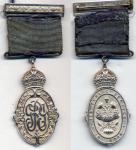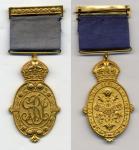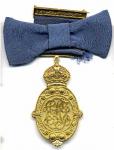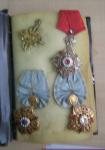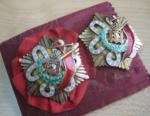-
Posts
14,343 -
Joined
-
Last visited
-
Days Won
25
Content Type
Profiles
Forums
Blogs
Gallery
Events
Store
Everything posted by Ed_Haynes
-

Kaisar-i-Hind Medal
Ed_Haynes replied to Ed_Haynes's topic in Great Britain: Orders, Gallantry, Campaign Medals
As with any honours system, compression and compantion and the ever growing need for "more" infected Indian honours in the 1930s and the Kaisar-i-Hind medal was no exception. In part, this came as a result of a general "aging" of the system and in part came from the increased demands being placed on government in the context of the rising tide of the Freedom Struggle. On 15 December 1933, a new Royal Warrant expanded the medal, adding a third class in bronze: http://www.gazettes-online.co.uk/archiveVi...;selHonourType= and http://www.gazettes-online.co.uk/archiveVi...;selHonourType= Occasional awards (in gold only) continued to be published in the London Gazette in the last years of the reign of George V. 29 December 1933 http://www.gazettes-online.co.uk/archiveVi...;selHonourType= 2 February 1934 http://www.gazettes-online.co.uk/archiveVi...;selHonourType= 1 June 1934 http://www.gazettes-online.co.uk/archiveVi...;selHonourType= 29 June 1934 http://www.gazettes-online.co.uk/archiveVi...;selHonourType= 28 December 1934 http://www.gazettes-online.co.uk/archiveVi...;selHonourType= 31 May 1935 http://www.gazettes-online.co.uk/archiveVi...;selHonourType= 19 November 1935 (special awards for Quetta earthquake) http://www.gazettes-online.co.uk/archiveVi...;selHonourType= and http://www.gazettes-online.co.uk/archiveVi...;selHonourType= 31 December 1935 http://www.gazettes-online.co.uk/archiveVi...;selHonourType= The death of George V on 20 January 1936 would initiate another redesign of the medal. It would also initiate a constitutional crisis. To represent medals of this period, I present a George VI bronze. -

Kaisar-i-Hind Medal
Ed_Haynes replied to Ed_Haynes's topic in Great Britain: Orders, Gallantry, Campaign Medals
-

Kaisar-i-Hind Medal
Ed_Haynes replied to Ed_Haynes's topic in Great Britain: Orders, Gallantry, Campaign Medals
The death of Edward VII and the accession of his son as King-Emperor George V led, once again, to a redesign of the badge by adding the new emperor's cypher. Yet the new king-emperor was different from his predecessors. He actually visited India and came face-to-face with one reality of the distanmt and almost independennt Indian honours system: when worn with other medals, the hollow Kaisar-i-Hind medal jingled most horribly and in what the new monarch felt was an unseemly fashion. This led to a redesign of the badge as a solid badge, discussed in the next section. It is, however, important to note that authorities in London never realised the badge had been redesigned, and continued to issue the hollow badge for those recipients resident in the United Kingdom, even as solid badges were being bestowed in India. The first variety George V Kaisar-i-Hind in gold shown here is the one awarded to Winifred, Lady Hardinge of Penshurst, C.I., K.i.H.. -

Kaisar-i-Hind Medal
Ed_Haynes replied to Ed_Haynes's topic in Great Britain: Orders, Gallantry, Campaign Medals
The queen's death and the accession of her son as King-Emperor Edward VII necessitated the redesign of the medal by substituting his cypher for hers on the obverse, but no changes were made beyond some fine-tuning of the hastily drafted royal warrant. See: http://www.gazettes-online.co.uk/archiveVi...;selHonourType= Perhaps the greatest momentary innovation of the Edward VII era was, however, the commencement of publishing at least one list of the recipients of the gold medal in the London Gazette: http://www.gazettes-online.co.uk/archiveVi...;selHonourType= Most honours lists, however, and all awards of the silver medal, were published only in the Gazette of India. One ongoing concern for the British administrators of India, and one which accelerated in the early decades of the twentieth century, was the ever-present danger of the proliferation of honors to the degree where they ceased to hold meaning. A useful insight into this problem was provided by the ex-Viceroy, Lord Curzon, who wrote to his successor from Egypt while on his way back to England at the conclusion of his tumultuous term as the crown?s representative in India: I have taken an immense amount of trouble in my time, making out columns for my own guidance so as to balance the respective interests of provinces (according to their size, importance, and population), creeds (Hindu, Mohammedan, Parsi), and class (official and non-official). I have also tried to honour and reward the silent workers in the Mufussil, even before those who had the luck to get to head-quarters and to obtain the spoils. I trust you will be sparing of the higher honours and not ladle out the G.C.S.I. and G.C.I.E. too freely among the Chiefs. Let them begin at the bottom and work their way up. . . . There is one practice against which I have consistently fought, but hitherto without success. It is that of making every Governor of Bombay and Madras a G.C.I.E. when he comes out and before he has done anything, and a G.C.S.I. when he goes home, whatever he has done. They, every one of these Governors, retires from India with exactly the same decorations as the Viceroy. Thus the spectacle of Beilby Wenlock being both a G.C.S.I. and a G.C.I.E. is absurd. The practice, moreover, is a modern innovation. I tried to revert to the old practice of making a Governor a K.C.S.I. to start with and of then giving him a G.C.I.E. when and if he deserved it, and a G.C.S.I. only in the event of his having been a conspicuous success. But the King is so fond of dealing out honours with a lavish hand that he would not agree, though George Hamilton did. I think I urged you at Bombay not to be too lavish with the Kaisar-i-Hind (there is a danger that it may become the perquisite of ladies and missionaries). It is very important to keep up its distinction and value. Local Governments will never remember that bars are given to this decoration as explained in my last circular letter of August. <Letter, Lord Curzon to Lord Minto, 25 November 1905, R/3/1/198 (IOR).> Curzon?s successor, Lord Minto, replied in a comparatively succinct fashion: ?I fully agree with you as to the necessity of avoiding the ?prostitution? of honours ? it is far too prevalent, and I have always inveighed against it.? <Letter, Lord Minto to Lord Curzon, 18 January 1906, R/3/1/198 (IOR).> For illustration, an Edward VII gold Kaisar-i-Hind, on slightly modified bow mount for a woman (mounting these for wear by women seems always to have posed a major challenge and never seems ever to have been "gotten right"). -

Kaisar-i-Hind Medal
Ed_Haynes replied to Ed_Haynes's topic in Great Britain: Orders, Gallantry, Campaign Medals
The Royal Warrant had been published in the London Gazette: http://www.gazettes-online.co.uk/archiveVi...;selHonourType= and http://www.gazettes-online.co.uk/archiveVi...;selHonourType= The Queen Victoria variety was apparently only awarded in the Birthday 1900 and New Years' 1901 honours lists (the queen died 22 January 1901). Awards, however, were not published in the London Gazette, being reserved to the Gazette of India (much like the Order of the Indian Empire). It is not possible at present to speak of the numbers awarded, but they must have been very few, possibly only ten in gold and twenty in silver. The medal was struck at the Calcutta Mint, at the Royal Mint, and by apponted jewellers such as Garrard. This is a silver Queen Victoria issue, made by Garrard (and in case): -

Kaisar-i-Hind Medal
Ed_Haynes replied to Ed_Haynes's topic in Great Britain: Orders, Gallantry, Campaign Medals
In May 1888, The Order of St. John of Jerusalem was incorporated by a royal charter from Queen Victoria. While the name would suggest otherwise, there was no direct historical connection with the ancient crusader hospitaller order, although the name served consciously to link the functions of the two. The Order of St. John was awarded to recognize humanitarian services, although the statutes specified that any individual appointed as a regular member of the order had to be a Christian and that non-Christians could be appointed only (and comparatively rarely) as associate members. While this opened the order to most British in India, it made the order largely irrelevant as a means of reward humanitarian work by Indians. In 1897, a major outbreak of the plague struck India, especially the Bombay Presidency. This medical emergency would influence in many ways the future course of Indian society. As it became necessary, however, to reward services rendered by Indian medical personnel in coping with the epidemic, a problem emerged; as the viceroy, Lord Curzon, wrote to the governor of Bombay late in 1899: For the last half-yearly distribution of honours you sent me a long list of recommendations for Native titles, many of which I granted. It seems to me, however, that Native titles, Rao Sahibs, Khan Bahadurs, &c., are not the best or proper form of reward for plague activity; and that at the rate at which they are now being shoveled out, their value will be permanently depreciated throughout India, and in your Presidency in particular. I am therefore considering whether it might not be possible to institute some Order of Decoration to be given for services rendered in the struggle against plague, famine, cholera, and such like visitations. It might be given to the soldiers who help you so splendidly as well as to civilians. Will you let me know your idea of the suggestion? <Letter, Viceroy to Governor of Bombay, 10 September 1899, R/3/1/195 (IOR).> Curzon may have had in mind the medal which had been instituted to reward service in the struggle against plague in Hong Kong. The Bombay governor concurred with the viceroy?s suggestions, agreeing that The Native titles have been of very great value both in rewarding some and in stimulating others, but of course I recognize that, with plague continuing, I could hardly ask you to go on at the same rate. I was very grateful for what you thought it right to give me. <Letter, Governor of Bombay to Viceroy, 18 September 1899, R/3/1/195 (IOR).> In October 1899, the viceroy outlined the need for a new award to the secretary of state for India: In connection with plague and famine, I shall send you by next mail definite proposals for the institution of some sort of medal with which to reward services in combating these two scourges, whether rendered by Europeans or Natives. The Queen spoke to me upon this matter before leaving England, and it is one upon which I solicit your influence and interest with her. At the present moment we are very poorly off for the means to reward services of the character which I am describing. The Order of the Red Cross can only be given to women and that for attending sick and wounded soldiers or sailors. The Order of St. John of Jerusalem is applicable to plague and is conferred upon both sexes, but it cannot be given to Natives. The only means we have so far discovered of rewarding the latter has been by giving them Native titles; and the number of these, notably in Bombay, is now becoming so prodigious, that the value of the honour has been seriously discounted, and I shrink greatly from a continuance of the process at the present rate. Hitherto, moreover, there has been no means of rewarding the admirable services rendered by English officers and soldiers in combating the plague. I am proposing, therefore, an Order of Indian Public Service, with two classes of medal, a gold and a silver, to be conferred either upon Europeans or Natives, and for services in respect either or plague or famine, or for civil merit of other description. I believe it will supply a much needed want, and I beg of you to help me with your energies in passing it through. <Letter, Viceroy to Secretary of State for India, 11 October 1899, R/3/1/195 (IOR).> The queen was consulted and granted her general approval. <Telegram, Queen-Empress to Viceroy, 10 November 1899, R/3/1/195 (IOR).> It was decided, for the 1900 New Year?s honors list, to go ahead with the award of titles as before, but to plan on the new medal, roughly along the lines of the Albert Medal, for the birthday honors list of 1900. <Telegrams, Secretary of State for India to Viceroy, 11 December 1899 and 9 January 1900, both in R/3/1/195 (IOR).> It was, however, the wish of the queen that rather than bear the vague name of ?Order of Indian Public Service?, the new decoration carry some appellation more obviously associated with her; the name ?Kaisar-i-Hind Medal? was suggested by the secretary of state for India and approved by the queen. <Telegram, Secretary of State for India to Viceroy, 22 March 1900, R/3/1/195 (IOR).> The new medal was approved in a royal warrant of 10 April 1900, for ?important and unusual service in the advancement of the public interest in India,? though the clear plague and famine connection was retained. The hollow medal, oval in shape with the queen's cypher on the obverse and an alaborate design of lotuses on the obverse bearing the legends "KAISAR-I-HIND" and "FOR PUBLIC SERVICE IN INDIA" , was to be awarded in two classes, the first class in gold awarded by the crown and the second class in silver awarded by the governor-general. Bars were authorized for subsequent awards of the medal in both classes. <Royal Warrant, 10 April 1900, R/3/1/196 (IOR); Dorling, Ribbons and Medals, p. 29; Mackay and Mussell, Medal Yearbook 2001, no. 38, p. 87. The medal would, subsequently, be revised by royal warrants of 8 July 1901, 9 July 1912, 2 November 1933, 24 June 1938, 21 December 1939, and 10 March 1945; see the correspondence in DO 142/304 (PRO).> From the inception of the award, however, confusion arose. The two classes (gold and silver) were seen as two separate awards, in part a reflection of their distinct sources of award (the crown and the governor-general). The award of a gold medal to an individual who had received a silver medal did not constitute a promotion within the medal (as was the case with the Indian Order of Merit). But, as the gold Kaisar-i-Hind Medal was an award from the monarch while the silver medal was just an award from her representative in India, it was considered to be expected that any recipient of the silver medal (even with bars) would return it if awarded the gold medal. <Note by R. Nathan, ?Principles to be Observed in Awarding Kaisar-i-Hind Medals,? 16 May 1905, R/3/1/196 (IOR).> Under normal circumstances ? i.e., in the absence of major events of famine or epidemic ? awards of the first class were to be limited to five in each of the two honors lists each year, while the silver medals should remain in the range of ten for each list (and they could certainly be fewer in number). <Circular letter from the Viceroy, 9 August 1905, R/3/1/196 (IOR).> The Kaisar-i-Hind medal (regardless of class) was not listed in the imperial order of wearing until 1904, but at that time it fell into the order of wearing of awards following the decorations awarded to officers in volunteer forces for long service and ahead of the various jubilee and coronation medals (which, as personal gifts of the sovereign, were worn ahead of campaign medals). <Tuson, ?Medals will be Worn?, p. 45.> -
As requested, I am putting up some VERY PRELIMINARY notes on the poorly documented and badly understood Kaisar-i-Hind Medal. Please treat these as preliminary observations in search of questions, commentary, and corrections. Eventually, I plan to take these (1) into an article in the JOMSA or OMRS journal and (2) into portions of a major book. Footnotes and references have been folded into the text. What you see here is very much a "work in progress". This note will be revised and edited and expanded over time. Watch this space . . . .
-
Not sure there's anyone here who reads Mongol bichig. Wish I could! Could you show some interior pages?
-

Pre-1947 Indian Gallantry groups
Ed_Haynes replied to Ed_Haynes's topic in Great Britain: Orders, Gallantry, Campaign Medals
The MC group isn't mine. I would leave them "as is", but I think the custodian has decided differently. It is not a simple matter of "choice", 'tis a matter of ethics: Different people, different ethics. I have left my mounted-as-worn group to H.H. Jamkhandi well alone! http://gmic.co.uk/index.php?showtopic=2400&st=1 -

Pre-1947 Indian Gallantry groups
Ed_Haynes replied to Ed_Haynes's topic in Great Britain: Orders, Gallantry, Campaign Medals
Yes. When you see original WWI-era ribbons, they usually look a lot like this. Most medals come to market naked, tied together with string. -

GURKHA VETERAN WANTS BRITAIN TO DO MORE.
Ed_Haynes replied to Kev in Deva's topic in Modern Campaigns and Conflicts
The interesting news will be when the new government renegotiates of just cancels the two foreign recruitment treaties. -

Mongolia Order of Civil Valour & Red Banner of Labour
Ed_Haynes replied to Vatjan's topic in People's Republic Mongolia
Much more, but he was 1- very much aware of Igor's site (as were most UB dealers), and used it as a benchmark, and 2- used to dealing with Russian and Chinese investors. -

Serbia Why do I collect YU-Awards
Ed_Haynes replied to Christian Zulus's topic in Southern European & Balkan States
For me, my interest in Yugoslavian awards such as it is, grows from two directions: -- As a logical outgrowth of my comparative interest of labor awards of the broadly-defined "Socialist" States. This has a personal political-ideological dimension. -- When I was first in India, a long time ago in a universe far far away, I was having some of the nice replicas made from the collection of the National Musuem (and had paid extra to get HIGHEST quality items done up). My items, however, got "stolen" for the honored guest for that January's Republic Day parade. In addition to making the folks at the Museum feel really guilty and getting a few extra items added into my set when it was finally ready, I (a humble graduate student) got invited to the reception where the guest of honor was presented with the replicas. The guest, of course, was Tito, and I got to meet him, drink with him, etc. Ever since, I have had a fond spot in my heart for Yugoslavia. -
-
I'm a little uncomfortable with posting images of items not in my collection, but as this and the following image were sent to me by the family of the recipient, I guess (hope?) it is OK. Order of King Faisal I Awarded for outstanding military and civilian services. Became obsolete with the Revolution. Established: 1932 Obverse: A nine-armed gold cross, enameled white. In the center, the gold bust of King Faisal I surrounded by a legend. Suspended by an open-work crown. Manufactured by Huguenin (Le Locle, Switzerland). Believed also to have been manufactured by Garards (London, England), ca. 1935-58 and by Arthus Bertrand (Paris, France) before 1935. Reverse: Plain. Ribbon: Pale blue with broad reddish-brown edges. Outline: -- first class ? sash, sash badge, and breast star (shown) -- second class -- third class
-

1914 "Mons" Star
Ed_Haynes replied to Riley1965's topic in Great Britain: Orders, Gallantry, Campaign Medals
Some are original-original (very uncommon for medals to Indians, as most come to the market stark naked), some are original ribbon replacements (found a couple of period rolls in an old military tailor's in Rawalpindi -- replacing ribbons is more accepted among British collectors than among, say, the Germans, no need for mad-science intervention), and some (Labh Singh's) are nasty modern ribbon. As I mentioned above, the old ribbon making firms can't replicate the hand-woven silk quality of the shaded ribbons; that skill is gone. -

1914 "Mons" Star
Ed_Haynes replied to Riley1965's topic in Great Britain: Orders, Gallantry, Campaign Medals
Just a few of mine, from soldiers otherwise forgotten and written out of history. Right to left, first row 1- 3370 SOWAR LABH SINGH, 9/HORSE WWI: 4 squadrons: 1-1/2 Sikhs (his), 1/2 Dogras, 1-1/2 Punjabi Muslims, 1/2 Pathans In France and Flanders from November 1914 until February 1918, in the 3rd (Ambala) Cavalry Brigade, 1st Indian Cavalry Division. Notable mounted action at Cambrai. Mid/late-1918 sent to Egypt and Palestine, where they were part of Allenby's offensive. After the war, they remained on for "police work" in Syria. Back to Ambala 1 January 1921. 2- No. 2107 A. L. DFR. MASSU KHAN, 36/HORSE To France with Lucknow Brigade. First action at Festurbert in January 1915; later in 2nd Ypres, the Somme, and Cambrai. Moved to Palestine in 4th Cavalry Division. Garrison dury in Syria and Palestine after the war. Back to India in 1921. 3- JEMDR. GULABA, 41/DOGRAS. Son of Si, of Sipal, Hamirpur, Kangra, Punjab. Enlisted 18 January 1893 Jemadar 8 April 1912 Indian Adjutant 1 July 1914 56 = musketry certificate 66 = course of transport instruction War Services: - N-W Frontier of India -- Chitral 1895 - Relief of Chitral CWGC: KIA 9 May 1915, NEUVE-CHAPELLE MEMORIAL, Panel 34 21st (Bareilly) Brigade, 7th (Meerut) Indian Division. WWI: 8 companies Dogras. second row: 4- No. 1006 SEPOY JAGAT SINGH, 47/SIKHS. 8th (Jullundur) Brigade, 3rd (Lahore) Infantry Division. WWI: 8 companies Sikhs. 5- No. 2255 SEPOY JAI RAM, 38/DOGRAS. Not in France as complete regiment, an "odd man". 6- No. 2428 RIFN. BUTHA SING NEGI, 1/39/GARHL. RIFS. 20th (Garhwal) Brigade, 7th (Meerut) Infantry Division. WWI: 8 companies Garhwalis. 7- 721 RESVT ARJAN SINGH, 20/HORSE Reservist, an odd rank. Son of Harnam Singh, of Chandanwal, Ludhiana, Punjab. CWGC: KIA 21 Deceber 1914; NEUVE-CHAPELLE MEMORIAL, Panel 7 9th (Secunderabad) Cavalry Brigade, 2nd Indian Cavalry Division. Served in France and Palestine in WWI. First honors at Givenchy in 1914. Then to Palestine for service in the Jordan Valley. WWI: 1 squadron Sikhs (his), 1 of Jats, 2 of Deccani Muslims. -
-

Mongolia Order of Civil Valour & Red Banner of Labour
Ed_Haynes replied to Vatjan's topic in People's Republic Mongolia
Given the rarity of these "first-generation" awards, this may be understood. These (type 1 and type 2) were among those offered to me in UB. But at prices even sillier than we see on Some Dealer's site. -

Mongolia Hero and labour Hero of the Mongolian People's republic
Ed_Haynes replied to Vatjan's topic in People's Republic Mongolia
Oh yes. Actually all of them were so made. -

Soviet Soviet & Eastern Block Quiz
Ed_Haynes replied to Christophe's topic in Russia: Soviet: Other Militaria
. . . and then wait to see what decision is made on your next visa application . . . .




